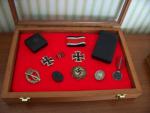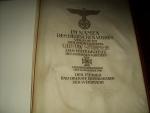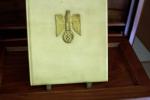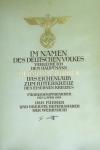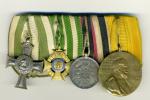
Bernhard H.Holst
For Deletion-
Posts
1,481 -
Joined
-
Last visited
Content Type
Profiles
Forums
Blogs
Gallery
Events
Store
Everything posted by Bernhard H.Holst
-
The Postman sometimes rings twice....
Bernhard H.Holst replied to Chris Boonzaier's topic in The Great War 1914 to 1918
I was able to only read the first four.. Bernhard H. Holst -
Hello readers. Here is an update to the above description of the combat to take the village of Tho Lao on May 17/18, 1952. Thanks are due to the German language web site www.more-majorum.de about German members of the French Foreign Legion during the Indochina conflict. Also the official French web site Memoire des Hommes listing the fatalities of the wars in which French forces were involved, was consulted. In addition the published account by an officer of the 3rd battailon of the 5.REI which first tried to enter the village but failed to take it until the following day was read. Unfortunately the tone of this account is much resented by this writer and fails to honor the loss of life on both sides and certainly the losses of his very own unit. This is an attempt to perhaps rectify that. So here then are the fatal losses of the III./5.REI on 17 May, 1952. - Caporal-Chef MACHT, Josef, DoB 31.07.1929, Germany - Caporal TROUSLIAUX BOTTECHIA GINO, Andre August Pierre, DoB 18.01. 1925 , France. - Leg. KRAUT, Jeno, DoB 23.09.1926. Hungaria. - Leg. PUJKON, Ignaz. DoB 19.05.1927, Romania. - Leg. PIMARE, Joseph Jules, DoB 01.11.1919, France. - Leg. OLIVIER, Rene Armand, DoB 04.07.1925, France. - Leg. BOHME, Willi, DoB 05.07.1932, Germany. - Rifleman Chuong A Bau, DoB 12.03.1930, Vietnam ( most likely the dead rifleman found in the morning of the 18.May in the firing line of the rifle platoon of Vietnamese from the 5.REI which was deloyed adjacent to us as reinforcement. He was probably hit by an errant round during the sporadic firing during the night.) Intermittenly French artillery fired on the village and adjacent area probably to interdict evasion and /or other activities with a massed firing shortly before the final push No losses apparently occurred during the final assault on the village against only slight resistance on the 18. May. This is based on the French site. While a number of prisoners were made and bodies found, it seems as if a good number of enemies could make their way through the encerclement during the night as they usually could. It is hoped that the above is a small token of remembrance due these comrades in arms. Bernhard H. Holst
-
Hello readers. Here is the K.C.formal document to the later Oakleaves recipient Ofw. Gustav Stuehmer whose military estate is in my care. The document is unsigned and most likely for that reason found no bidder on an auction. Bernhard H. Holst Note: the oakleaves are not part of the estate but were lost post war. Awarded after death. [
-
Hello: I looked at the auction offer of the K.C. and document. As regards the document without being knowledgeable there are three obvious items which shout at me"DO not go near it!!". - the set-up with the "dem" off alignment; - flourishing script; -the additional "Meissner" signature which never appeared on such or similar document. In addition the "Blindpraege Siegel" ( embossed seal ) seems to show and there should not be such thing. Bernhard H. Holst
-
Hello readers. I have not seen a like document pictured here ( unless mistaken). So I present the one in my care. Recipient Hptmann Heinrich Schueler ( umlaut u). The Knights Cross was bestowed on 18.Sep.1942. He was also the recipient of the German Cross i.Gold with date of 28. Feb. 1942. This officcer began the war as a n.c.o. and held the rank of Oberst d.R. when killed on 12.Jan.1945. Bernhard H. Holst
-
Hello readers. In the entry # 1 I was able to add two names of my Vietnamese comrades who lost their lives for their country namely: - Cavalier 1.cl. Nguyen, Van Thuong, and - Bui, Van Thong. The French official website SGA Memoire des Hommes gives the means to now research fatal losses for the war in Indochina by inserting only single criteria. Unfortunately numerous transscription errors occured while compiling these valuable lists. They mainly can be found in place names in Indochina and for members of the French Foreign Legion, names distorted, unit nomenclatures and so on. Also it seems certain that some personnel did not find their way into these lists. Bernhard H. Holst
-
Hello readers. Pictured below is a medal bar containing several non-combattant medals of diferent German States; - Prussia, Cross for voluntary war aid; - Prussia, Red Cross Medal 3.class; - Oldenburg, Friedrich August Cross with non-combattant ribbon; - Mecklenburg Schwerin, Military Merit Cross with ]non-combattant ribbon; - Hindenburg, non-combattant version; - Austria comm. medal; - Austria Red Cross medal with war distinction. Bernhard H. Holst
-
Hello readers. I came across an old ( 1960 ) issue of the French Foreign Legion monthly publication "Kepi Blanc" which contains an article concerning the history of certain items of uniform and associated items. The article was based on a pamphlet for newly joined officers for familiarization purposes. - Kepi Blanc ( white covered headgear) was introduced to the public during the 14.July 1939 parade. After some changes during the 1800's in head gear including different covers and the introduction of sun helmets the regulation dark-blue with red top kepis were mostly worn. Khaki covers were introduced mainly to preserve the blue and red colors and those became whitish through the bleaching by the sun and the many washings. Some units wore white summer uniforms with which white covered kepis were worn. With winter uniforms troops reverted to the base blue/red kepis . Gradually the white covered kepi was introduced and by the summer of 1939 generally adopted. The 13.DBLE following the Narvik operation was based on Great Britain and adopted the khaki beret. But during the 18 June 1945 parade the Kepi Blanc was worn. The 1.REC and the RMLE always wore the Kepi Blanc. The 13.DBLE while deployed in Indochina still wore the khaki beret except during formal occasions and photos during the Algeria operations also show them in wear. - The grenade with seven flames. The grenade emblem was reserved to certain elite formations and it was worn by the Legion ssince 1874. Over time it evolved into a grenade with seven flames of which two show them to return. - Green neck tie. This paricular color scheme was introduced in 1945 by utilising recovered stock. - Epaulettes. Introduced in different colors to distinguish units on the battlefield. The green and red colors of the Legion were implemented in 1864. Fallen in disuse on two occasions over the years they were adopted permanently as of 1930. - Ceinture Bleue. The dark-blue wrap around the midriff, is based on the 1882 accessory which was meant to protect against intestinal ailments. It evolved into the present dark-blue color and as an ornament to parade dress. - Pioneer dress. The leather aprons and the axe being carried go back to Imperial times. The beards worn also have a long history. Bernhard H. Holst
-
France Ritterkreuz with Oakleaves winner, rare photos.....
Bernhard H.Holst replied to Chris Boonzaier's topic in France
Hello Chris. The mention of him having also received the Oakleaves to the Knightscross is in error. The German magazine Ritterkreuz Archiv of some time back has an article about him. Bernhard H. Holst -
EK 1914 Trench Raid EK1 Document
Bernhard H.Holst replied to Chris Boonzaier's topic in Germany: All Eras: The Iron Cross
Hello Chris. Two neat documents. Thanks for showing them. Bernhard H. Holst -
Hello readers: I have had a look at some volumes of the publications by the Reichsarchiv, the ones I hve are all pertaining to battles on the Western Front. O.o.B. for the Battle of Verdun makes no mention of Kampfgruppe among infantry formations, up to late 1916. For artillery it lists some formations with the term of "Gruppe" ( not Kampfgruppe ). Some few are titled after location and more numerous are those titled after commanders. Bernhard H. Holst
-
Hello Rick. The German term "Kampfgruppe" was introduced on a wide scale only with WW II. In my readings of WW I combat actions/operations which appeared after the war and were prepared by the Reichsarchiv, the term "Kampfgruppe" does not appear for any formations which contained infantry units. I will do some research in those volumes which have Orders of Battle and post my findings. Another finding by Andy, above shows detailed / by battery descriptions, Wechselstellung for example which would be of little value for infantry to have knowledge of. Bernhard H. Holst

